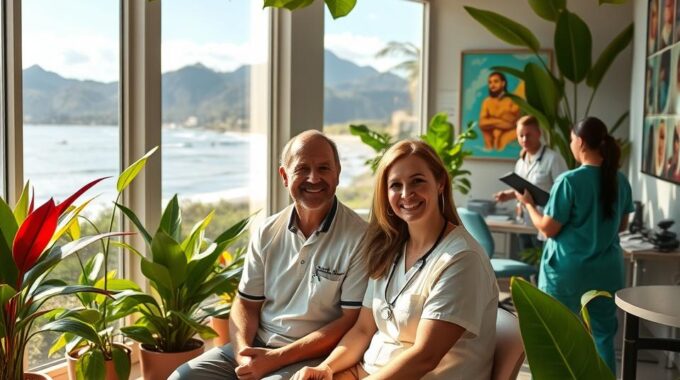As a hub for international workers and service providers, Costa Rica has introduced Law No…

Costa Rica’s CAJA System: Healthcare Explained
Imagine getting top-notch healthcare without breaking the bank. Costa Rica’s CAJA System makes this dream a reality. It’s a universal healthcare model that covers everyone, making it a hit with expats too. The CAJA System ensures everyone gets the medical care they need, no matter their income.
Key Takeaways
- The CAJA system provides universal healthcare coverage for all residents of Costa Rica.
- Healthcare costs represent a manageable percentage of income, ranging between 7% to 11% for contributions.
- Costa Rica ranks 36th in the world for healthcare quality according to the World Health Organization.
- Emergency services are available free of charge to all, reinforcing the commitment to accessible healthcare.
- Enrollment in the CAJA system is essential for legal residency or citizenship holders in Costa Rica.
Overview of the Costa Rica Healthcare System
The Costa Rica healthcare system is known for its universal coverage. It meets the needs of its people. The Caja Costarricense de Seguro Social (CCSS) manages it, with about 30 hospitals and many clinics across the country.
This ensures everyone gets the medical care they need. It’s a big deal for both locals and expats.
Universal Healthcare Model
About 91% of the population gets covered under this model. It’s funded by income-based contributions. People pay between 7% and 11% of their monthly salary.
This makes healthcare affordable. Costa Rica’s system offers a lot, like emergency care and specialist visits. It also covers general check-ups, preventive care, and prescription meds at public pharmacies.
Ranks and Recognitions
Costa Rica’s healthcare is among the top 20 globally, according to the United Nations. People live up to 80 years on average, showing the system’s quality. The World Health Organization ranks it 36th, beating the U.S. and Cuba.
This shows Costa Rica’s dedication to healthcare. It plans to spend over $3 billion in the next 20 years. This will help make healthcare even better for its people.
What is the CAJA System in Costa Rica Healthcare?
The Caja system, also known as the Costa Rican Social Security Fund (CCSS), has been key to national healthcare since the 1940s. It shows Costa Rica’s dedication to providing full healthcare services. It helps both citizens and residents get the care they need.
Historical Context
The Caja system was set up to meet the health needs of the people. Over the years, it has grown and changed a lot. Now, it uses premiums and taxes to cover everyone. It supports many hospitals and clinics across the country.
Key Features of the CAJA System
The caja system has many important features that make healthcare better in Costa Rica:
- Affordability: Monthly premiums are a small part of people’s income. This makes healthcare affordable for many.
- Comprehensive Coverage: It covers all medical treatments, including surgeries, tests, and medicines.
- Emergency Services: People get free emergency care. This includes help for those without papers.
- Extensive Network: There are many healthcare places, like caja hospitals in Costa Rica. This makes health services easy to find.
- Preventive Care: The system focuses on keeping people healthy. This helps improve health in the long run.

Eligibility and Enrollment in the CAJA
To get into the CAJA system, knowing who can join is key. The Costa Rican healthcare system requires everyone, including expats, to sign up for CAJA. This rule helps make sure everyone gets the health care they need, keeping the community healthy.
Who Can Join the CAJA?
Many groups can join the CAJA, making it open to all. The main groups include:
- Permanent residents of Costa Rica
- Temporary residents
- Immigrants planning to stay long-term
- Dependents of the main subscriber, like kids under 18, who get coverage for free
Knowing who can join the CAJA helps people get health care. It also means families don’t have to pay extra for their kids’ medical needs.
Steps to Enroll in the System
Joining the CAJA is easy and quick. Here’s how to do it:
- Get proof of where you live, like a lease or bill.
- Go to the local CAJA office or their website.
- Fill out the application and bring your documents.
- Pay a monthly fee, which is 7% to 11% of your income.
This clear process lets people enjoy the benefits of CAJA. It helps them get affordable health care all over the country.
Costs and Contributions to the CAJA
It’s important for people living in Costa Rica to know how the CAJA system works. This system helps make sure everyone gets quality healthcare. It’s based on how much money you make.
Understanding the Payment Structure
The CAJA system has different rates based on how much you earn. Employers pay about 26.67% of what an employee makes. Employees pay around 10.67% of their income. This money helps pay for many health insurance benefits, like doctor visits and treatments.

Monthly Contributions Based on Income
People in Costa Rica pay 8% to 12% of their income each month for CAJA. For example, someone making $1,500 a month might pay $201. If you make $2,500, you could pay about $396. These payments help keep the healthcare system running.
Starting in 2024, there will be big changes in how much people pay. Pensionados and Inversionistas will have to pay almost double what they do now. It’s key to pay on time, by the 8th of each month, to avoid penalties and keep access to healthcare.
The CAJA system is a key part of Costa Rica’s healthcare. It helps make sure everyone gets the care they need without spending too much. Both employers and employees contribute, making sure everyone is covered.
Healthcare Services Provided by CAJA
The CAJA system offers a wide range of healthcare services. This ensures that everyone can get the medical care they need. From simple visits to complex treatments, CAJA has you covered. This is thanks to Costa Rica’s focus on public health and making care affordable.
Medical Procedures and Treatments Covered
With caja medical coverage, you get help for many important procedures. These include:
- General practitioner visits
- Inpatient and outpatient surgeries
- Maternity and gynecological care
- Pediatric services
- Mental health support
- Dental services
These services show the CAJA system’s strength and commitment to health. They also make healthcare more affordable. This means more people can get the care they need without breaking the bank.
Access to Emergency Services
Emergency services are a key part of caja healthcare coverage. For everyone, emergency care is free. This shows Costa Rica’s commitment to urgent care.
With hospitals all over the country, help is always close by. This quick response is crucial in health emergencies. It’s a big part of Costa Rica’s public health.
To learn more about the CAJA system, visit this page. Quality healthcare is available to all. This ensures everyone gets the medical attention they need without financial stress.
Differences Between Public and Private Healthcare
Costa Rica has a mix of public and private healthcare. This mix gives people choices based on what they can afford and what they prefer. Each system has its own benefits and challenges, affecting how well people can get medical care.
Public Healthcare Advantages
The public healthcare in Costa Rica, run by CAJA, is known for being affordable and accessible. Its main benefits are:
- Lower Costs: The public system is funded by payroll taxes, which are 7%-11% of what people earn. This makes healthcare affordable for many.
- Comprehensive Coverage: It offers a wide range of services, including emergency care without extra cost. This ensures everyone gets the medical care they need.
- Universal Access: Everyone must use the public healthcare system, making it inclusive for all.
Private Healthcare Options
More people in Costa Rica are choosing private healthcare. Private healthcare has its own strengths, such as:
- Faster Services: Private clinics often have shorter wait times, which is good for those who need quick care.
- Greater Flexibility: People can pick their healthcare providers, leading to care plans that fit their needs.
- Comprehensive Plans: Private healthcare costs can vary from $100 to $1,000 monthly, depending on the coverage.
Challenges Faced by the CAJA System
The CAJA system in Costa Rica has many strengths but also faces big challenges. One major issue is long wait times for non-emergency care. Patients often wait a long time, which can make them unhappy with the service.
This problem shows the need for better improvements in the CAJA system. It’s important to make healthcare more accessible and timely for everyone.
Long Wait Times
Long wait times are a big problem for the CAJA system. People needing special care often wait for months. The need for imaging services is high, but there aren’t enough radiologists.
The government is working hard to fix these wait times. They want to make sure everyone gets the healthcare they need quickly.
Quality of Service in Rural Areas
The quality of healthcare varies a lot in Costa Rica. Urban areas have better facilities, but rural areas struggle. They have less access to special care and resources.
To fix this, the government needs to invest in rural areas. They should improve the infrastructure and train more staff. This will help make healthcare better for everyone in Costa Rica.
Even with its challenges, the CAJA system is key to Costa Rica’s universal healthcare. The government is working hard to make it better. They know how important it is for all Costa Ricans.
To learn more about the challenges of Caixa system and its effects, click the link. Fixing these issues is crucial for fair healthcare access across the country.
Private Health Insurance in Costa Rica
In Costa Rica, many people choose private health insurance. They want quicker service and more healthcare options. Private insurance in Costa Rica means faster medical help and coverage for special treatments.
Benefits of Supplemental Private Insurance
Supplemental private insurance has many benefits. It’s great for those who want more than CAJA offers. Some key advantages include:
- Access to quicker consultations and treatments, reducing wait times typically associated with public healthcare.
- Unlimited coverage options available with plans like the Cigna Global Health Plan, which includes a comprehensive range of services such as surgeries, diagnostic tests, and emergency medical evacuations.
- Flexibility in choosing healthcare providers, allowing individuals to select from popular private healthcare facilities known for their quality of care, including Hospital CIMA and Clínica Bíblica.
- Robust plans like the GeoBlue Xplorer Global Plan, which is ideal for US citizens, connecting them to a global network of doctors.
Popular Private Healthcare Facilities
Costa Rica has many top-notch healthcare facilities. They serve both locals and expats. These places are known for their quality and medical skills:
- Hospital CIMA – A leading choice that provides advanced medical services and is equipped with cutting-edge technology.
- Clínica Bíblica – Famous for its exceptional care and a wide range of specialties, making it a popular destination for patients seeking specialized treatments.
- Clinica Santa Rita – Offers a variety of health services tailored to meet individual needs, contributing to the overall excellence of Costa Rican healthcare.
Many choose private health insurance for better healthcare. It’s also a big draw for medical tourism in Costa Rica. For more on healthcare in Costa Rica, check out this link.
Impact of the CAJA System on Expats
The CAJA system offers big benefits for expats in Costa Rica. It helps with healthcare costs and access. After getting residency, expats can join the public healthcare system.
Healthcare Access for Foreign Residents
Expats get full healthcare access. This includes doctor visits, hospital stays, and emergency care. The monthly CAJA fees are based on income, from 7% to 11%.
These fees are much lower than in many countries. For example, a doctor’s visit costs about $30. This shows how affordable the CAJA system is.
Cost Benefits for Expats
The CAJA system is great for expats’ wallets. Costa Rica’s cost of living is about 30% lower than in the U.S. A single person can live well on $1,600 to $2,000 a month.
Rent and groceries are nearly 30% cheaper than in the U.S. This lets expats save money on healthcare and other expenses.

Expats find the CAJA system a good choice for healthcare. It’s affordable and fits their lifestyle in Costa Rica without breaking the bank.
For more on the CAJA system, check out Costa Rica’s healthcare options.
Conclusion
The CAJA system is key to Costa Rica’s healthcare, offering wide public health insurance. It shows the country’s dedication to fairness and easy access to health care. It covers a lot, from check-ups to surgeries, and even retirement benefits.
It helps both locals and expats who want to live in a welcoming place. This makes it a big part of the country’s health system.
Improving CAJA is crucial to tackle its problems, like long waits and uneven service in rural areas. The system is getting better, thanks to new projects like the Unified Digital Health Record (EDUS). This has made things smoother and helped doctors make better choices.
This shows the system’s strength and its aim to serve everyone well. For more info on CAJA and its benefits, check out this resource.
Source Links
- https://crie.cr/health-care-in-costa-rica-caja/
- https://startabroad.com/locations/costa-rica-country-guide/costa-rica-healthcare-and-insurance/
- https://en.wikipedia.org/wiki/Healthcare_in_Costa_Rica
- https://crie.cr/costa-rica-healthcare-system/
- https://www.trade.gov/country-commercial-guides/costa-rica-healthcare-sector
- https://www.gaprealestate.com/healthcare-in-costa-rica-for-expats/
- https://flamingobeachrealty.com/healthcare-in-costa-rica/
- https://www.cgcoldwellbankerjacobeach.com/blog/understanding-costa-rican-healthcare
- https://www.tresamigos-cr.com/medical-care-costa-rica
- https://crie.cr/costa-rica-healthcare-system-for-immigrants/
- https://gap.cr/private-health-insurance-in-costa-rica/
- https://www.specialplacesofcostarica.com/blog/does-costa-rica-have-good-healthcare-for-expats/
- https://crie.cr/understanding-costa-rica-caja-fees-what-you-need-to-know-in-2024/
- https://crie.cr/rates-for-caja-ccss-contributions-in-costa-rica/
- https://www.internationalinsurance.com/health/north-america/costa-rica.php
- https://international-sante.com/healthforexpats/expat-insurance/country/costa-rica/
- https://ucsdsomghac.com/2024/02/15/costa-rica-immersion-in-healthcare-system/
- https://costaricarealestate.net/a-closer-look-at-healthcare-in-costa-rica-a-model-of-success/
- https://www.worldbank.org/en/country/costarica/publication/como-programa-banco-mundial-salud-logro-importantes-avances-costa-rica
- https://www.gaprealestate.com/is-costa-rica-cheap-for-expats/
- https://brighttax.com/blog/retire-in-costa-rica/
- https://publications.iadb.org/publications/english/document/Costa-Ricas-Unified-Digital-Health-Record-EDUS-System-Best-Practices-History-and-Implementation.pdf
- https://www.gaprealestate.com/are-there-good-private-hospitals-in-costa-rica/


